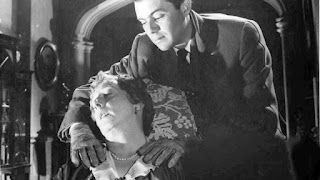Directed by Howard W. Koch and Edmond O'Brien; produced by Aubrey Schenck
By the 1950s, it seemed that police detectives in American movies had changed from the manner in which they were depicted in the 1930s and ‘40s. In the earlier era, they often dressed in the same well-pressed suits as the higher class villains they pursued, and if they mentioned their low salaries, it was usually with humorous resignation. By 1954, the cops were rumpled, tired, fed up and one night-shift away from becoming criminals themselves.
Shield for Murder is a prime example of this trend. The view of a policeman’s lot is a bleak one, with constant references made to dirt, filth, garbage, etc. (At one point, a police captain, ordering his subordinates to arrest someone, tells them, “All right, go out and rub your faces in the mud. Bring him in.”) This fits with the plot, which details the exploits of a cop gone bad (Edmond O’Brien) in his attempt to obtain what he thinks he should have out of life. The first scene shows him murdering a bookie for the $25,000 he is carrying, and, remarkably, this is not as bad as it gets for him. With his suspicious colleagues on his trail and a local mobster wanting his money, killing someone turns out to be the easy part for our protagonist.
Shield for Murder is a low-budget film. This is seen, literally, in the shadow of a boom-microphone visible within the first minutes. The scene wasn’t re-shot, probably due to financial constraints. Later, a show-home serves as the setting for a scene, and the company that built it is named as ‘Kling’. In the credits, Kling is listed as a genuine company, having provided the show-home - probably for free in consideration of being mentioned in the dialogue. Also, some generic shots of police cars are used more than once.
Small budgets do not kill movies (in some instances, they can be the saving grace), and when they are a disadvantage, they can be made up in other ways. But the dialogue here is only adequate, and the direction, shared by star O’Brien, is routine, except in some action scenes; the shoot-out at the swimming pool is especially exciting. However, the principal supporting players (John Agar, Marla English) are not impressive. Their acting is stiff, especially compared with O’Brien’s. Also to be seen in minor roles are a young Claude Akins, Carolyn Jones (“The Addams Family”), Richard Deacon (The Dick Van Dyke Show”) and William Schallert. The first two in particular are examples of how character actors can brighten a lacklustre film.
And Shield for Murder, unfortunately, does not shine. O’Brien does well. He is not necessarily under-rated as an actor, but is, I think, under-appreciated. He gives solid performances in films. He had a brief period as a leading man but by 1954 was already moving into supporting roles, where his talents were better used. But B-movies such as Shield for Murder allowed less prominent actors to come to the forefront, just as independent features do today. Here, O’Brien gives three dimensions to what another performer would portray as cardboard. His crooked cop is not evil, but he is bad. When he finds a witness to his initial crime, he doesn’t try to hurt him, but attempts to bribe him. His hatred is for the low-level criminals with whom he must deal every day. And there is a rage in his character that is frightening to see.
Despite this, the uneven film is rather run-of-the-mill; the viewer knows how it will end. The story provides no surprises, the script not enough life. Certainly, O’Brien is worth seeing, but, despite a few other attractions, he is not enough to hold up a Shield for Murder.































